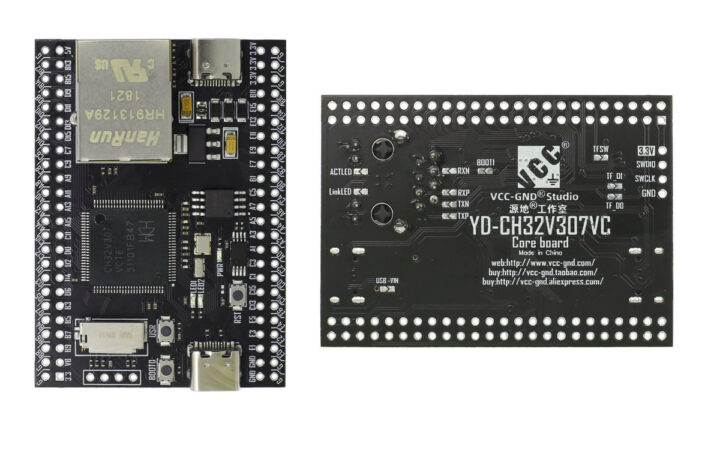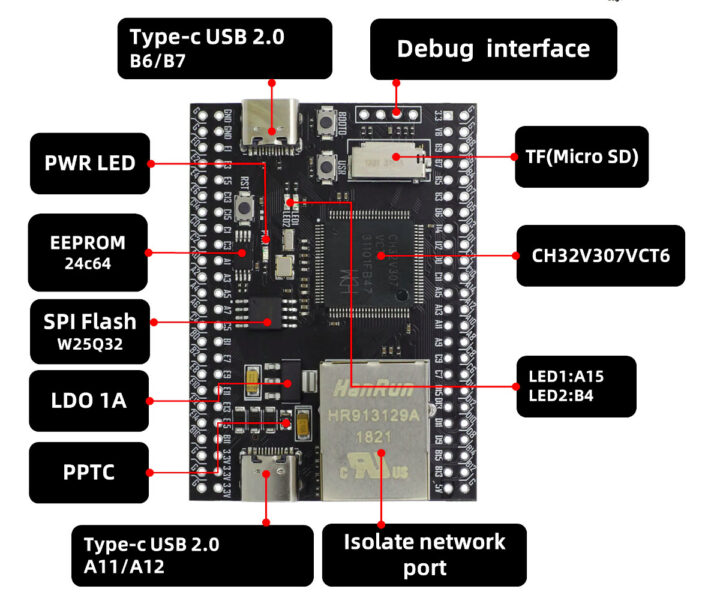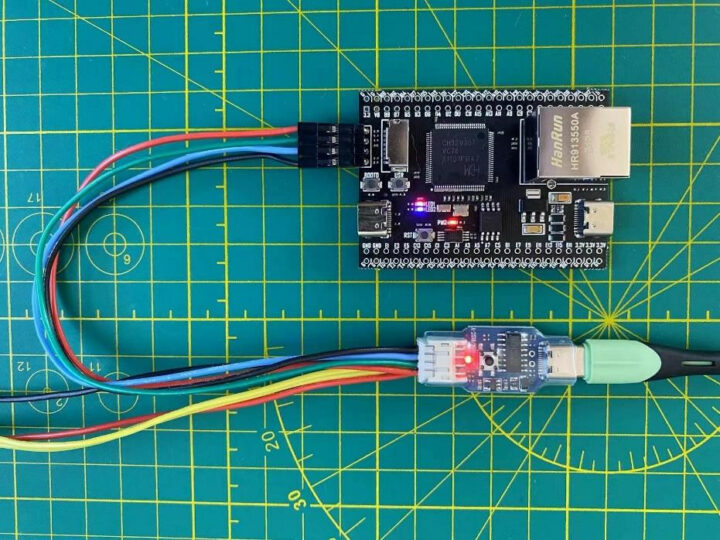At the beginning of the year, we wrote about WCH CH32V307 RISC-V microcontroller and a development board with 8 UART ports controlled over Ethernet. I’ve now been informed of a similar, but much more compact by VCC-GND Studio named “YD-CH32V307VCT6”.
Besides the 144 MHz RISC-V microcontroller, the board features a 10Mbps Ethernet port, two USB Type-C ports, SPI flash, EEPROM, a microSD card socket, and four rows of 24 pins each for a total of 96 pins exposing all pins out of the LQFP100 package.
YD-CH32V307VCT6 board specifications:
- MCU – WCH CH32V307VCT6 32-bit RISC-V microcontroller @ 144 MHz with 256K Flash, 64K SRAM
- Storage – 32Mbit SPI NOR flash (W25Q32), 64kbit EEPROM (24C64), MicroSD card slot
- Networking – 10 Mbps Ethernet
- USB – 1x USB 2.0 Type-C port (High Speed: 480 Mbps), 1x USB 2.0 Type-C port (Full Speed: 12 Mbps)
- Expansion – 2x 48-pin headers with
- 2 x 12-bit DAC
- 2-unit 16-channel 12-bit ADC
- 16-channel TouchKey.
- 2x USARTs, 5x UARTs.
- 2x CAN interfaces (2.0B active).
- SDIO interface
- 2x I2C, 3x SPI interfaces
- 2x I2S interfaces.
- Up to 80x GPIO ports, with up to 16 external interrupts
- Etc…
- Debugging – 4-pin debug interface (GND, CLK, DIO, 3.3V) with YD-Link or WCH-Link debugger
- Misc – 2x user LEDs, Power LED, Reset button, user button, BOOT0 button
- Power Supply
- 5V via USB port
- 1A LDO
- PPTC (polymeric positive temperature coefficient) device aka resettable fuse
- Dimensions – 62.48 x 44.70 mm
Either USB port can be used to flash the firmware with WCHISPTool (Windows only) and programming can be done in MounRiver Studio IDE that is said to be similar to the Arm Keil MDK, and available for both Windows and Linux, which is said to include a download tool too (So WCHISPTool may not be necessary?). You’ll also find the CH32V307VCT6 datasheet and reference manual, as well as code samples on Github. That repository is for the WCH board, but it should also work on the VCC-GND Studio board with minimal modifications (or none at all).
You may also want to get the YD-Link debugger, shown above connected to YD-CH32V307VCT6 board, for easier debugging. VCC-GND Studio also stores some documentation about the board and debugger, but only/mostly in Chinese.
The YD-CH32V307VCT6 board can be purchased on Aliexpress for $9.50 plus shipping, but there’s also a $12 “Board Dugger” option that I would assume include the RISC-V Ethernet I/O board and the YD-Link debugger, but it’s not explicitly stated.
While the documentation seems all over the place, there’s been what I would call a “positive vibe” about WCH since the end of last year. This started with the company opening the openwch Github account containing resources for their microcontrollers and other chips, then I noticed Patrick Yang, the Technical Director at WCH, getting involved and responsive and Twitter, and I’ve been reading some positive feedback including recently from Olimex:
Just want to share that @WCH_TECH @Patrick_RISCV provide incredible support for their customers! We reported bug in CH9344L Linux driver and it was fixed just in few days. You guys are amazing! There will be lot of Olimex boards with your ICs in the future.
If only they would get a support forum or mailing list it would even help more people, as Twitter is not exactly the best solution to keep a history of common problems, or report bugs.
Thanks to Theguyuk for the tip.

Jean-Luc started CNX Software in 2010 as a part-time endeavor, before quitting his job as a software engineering manager, and starting to write daily news, and reviews full time later in 2011.
Support CNX Software! Donate via cryptocurrencies, become a Patron on Patreon, or purchase goods on Amazon or Aliexpress







